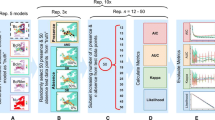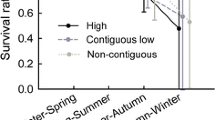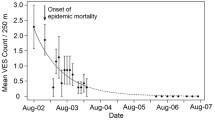Abstract
Decision-analytic models provide forecasts of how systems of interest will respond to management. These models can be parameterized using empirical data, but sometimes require information elicited from experts. When evaluating the effects of disease in species translocation programs, expert judgment is likely to play a role because complete empirical information will rarely be available. We illustrate development of a decision-analytic model built to inform decision-making regarding translocations and other management actions for the boreal toad (Anaxyrus boreas boreas), a species with declines linked to chytridiomycosis caused by Batrachochytrium dendrobatidis (Bd). Using the model, we explored the management implications of major uncertainties in this system, including whether there is a genetic basis for resistance to pathogenic infection by Bd, how translocation can best be implemented, and the effectiveness of efforts to reduce the spread of Bd. Our modeling exercise suggested that while selection for resistance to pathogenic infection by Bd could increase numbers of sites occupied by toads, and translocations could increase the rate of toad recovery, efforts to reduce the spread of Bd may have little effect. We emphasize the need to continue developing and parameterizing models necessary to assess management actions for combating chytridiomycosis-associated declines.

Similar content being viewed by others
References
Armstrong DP, Seddon PJ (2008) Directions in reintroduction biology. Trends in Ecology and Evolution 23:20–25.
Bataille A, Cashins SD, Grogan L, Skerratt LF, Hunter D, McFadden M, et al. (2015). Susceptibility of amphibians to chytridiomycosis is associated with MHC class II conformation. Proceedings of the Royal Society B 282:20143127.
Berger L, Speare R, Daszak P, Green DE, Cunningham AA, Goggin CL, et al. (1998). Chytridiomycosis causes amphibian mortality associated with population declines in the rain forests of Australia and Central America. Proceedings of the National Academy of Sciences 95:9031-9036.
Brannelly LA, Hunter DA, Skerratt LF, Scheele BC, Lenger D, McFadden MS, et al. (2015). Chytrid infection and post-release fitness in the reintroduction of an endangered alpine tree frog. Animal Conservation DOI:10.1111/acv.12230.
Burgman M (2005). Risks and Decisions for Conservation and Environmental Management. Cambridge University Press, Cambridge, UK.
Burgman M, Carr A, Godden L, Gregory R, McBride M, Flander L, et al. (2011). Redefining expertise and improving ecological judgment. Conservation Letters 4:81-87.
Canessa S, Converse SJ, West M, Clemann N, Gillespie G, McFadden M, et al. (In Press). Planning for ex situ conservation in the face of uncertainty. Conservation Biology DOI: 10.1111/cobi.12613
Chandler RB, Muths E, Sigafus BH, Schwalbe CR, Jarchow CJ, and Hossack BR (2015). Spatial occupancy models for predicting metapopulation dynamics and viability following reintroduction. Journal of Applied Ecology 52:1325-1333.
Clobert J, Baguette M, Benton TG, and Bullock JM (2012). Dispersal ecology and evolution. Oxford University Press.
Converse SJ, Moore CT, and Armstrong DP (2013a). Demographics of reintroduced populations: estimation, modeling, and decision analysis. Journal of Wildlife Management 77:1081-1093.
Converse SJ, Moore CT, Folk MJ, and Runge MC (2013b). A matter of tradeoffs: reintroduction as a multiple objective decision. Journal of Wildlife Management 77:1145-1156.
Ewen JG, Sainsbury AW, Jackson B, and Canessa S (2015). Disease risk management in reintroduction. Pages 43-57 in D. P. Armstrong, M. W. Hayward, D. Moro, and P. J. Seddon, editors. Advances in Reintroduction Biology of Australian and New Zealand Fauna. CSIRO Publishing, Collingwood, Victoria, Australia.
Fisher MC, Garner TWJ, and Walker SF (2009). Global emergence of Batrachochytrium dendrobatidis and amphibian chytridiomycosis in space, time, and host. Annual Review of Microbiology 63:291-310.
Gonzalez A, Ronce OFR, and Hochberg ME (2013). Evolutionary rescue: an emerging focus at the intersection between ecology and evolution. Philosophical Transactions of the Royal Society B 368:1610
Gregory R, Failing L, Harstone M, Long G, McDaniels T, and Ohlson D (2012). Structured Decision Making: a Practical Guide to Environmental Management Choices. Wiley-Blackwell, Oxford, UK.
IUCN/SSC (2013) Guidelines for Reintroductions and Other Conservation Translocations. Version 1. Gland: IUCN Species Survival Commission
Keeney RL (1992). Value-Focused Thinking: a Path to Creative Decisionmaking. Harvard University Press, Cambridge, USA.
Kuhnert PM, Martin TG, and Griffiths SP (2010). A guide to eliciting and using expert knowledge in Bayesian ecological models. Ecology Letters 13:900-914.
Lanier WE (2015) Investigating direct and indirect effects of greenback cutthroad trout on boreal toad recruitment. M.S. Thesis. Colorado State University, Fort Collins,
Lips KR (2008). Decline of a tropic montane amphibian fauna. Conservation Biology 12:106-117.
Longcore JE, Pessier AP, and Nichols DK (1999). Batrachochytrium dendrobatidis gen et sp nov, a chytrid pathogenic to amphibians. Mycologia 91:219-227.
MacKenzie DI, Nichols JD, Royle JA, Pollock KH, Bailey LL, and Hines JE (2006). Occupancy estimation and modeling: inferring patterns and dynamics of species occurrence. Academic Press, Amsterdam.
MacMillan DC, and Marshall K (2006). The Delphi process-an expert-based approach to ecological modelling in data-poor environments. Animal Conservation 9:11-19.
Martin TG, Burgman MA, Fidler F, Kuhnert PM, Low-Choy S, McBride MF, et al. (2011). Eliciting expert knowledge in conservation science. Conservation Biology 26:29-38.
Maslo B, and Fefferman NH (2015) A case study of bats and white-nose syndrome demonstrating how to model population viability with evolutionary effects. Conservation Biology. 29:1176-1185
McBride MF, Fidler F, and Burgman MA (2012). Evaluating the accuracy and calibration of expert predictions under uncertainty: predicting the outcomes of ecological research. Diversity and Distributions 2012:782-794.
McCarthy MA, Armstrong DP, and Runge MC (2012). Adaptive management of reintroduction. Pages 256-289 in J. G. Ewen, D. P. Armstrong, K. A. Parker, and P. J. Seddon, editors. Reintroduction Biology: Integrating Science and Management. Wiley-Blackwell, Oxford, UK.
McGowan CP, Runge MC, and Larson MA (2011). Incorporating parametric uncertainty into population viability analysis models. Biological Conservation 144:1400-1408.
Meyer MA, Booker JM (1990) Eliciting and Analyzing Expert Judgment: A Practical Guide. Office of Nuclear Regulatory Research, Division of Systems Research. U.S. Nuclear Regulatory Commission, Washington DC, USA
Moore JL, and Runge MC (2012). Combining structured decision making and value-of-information analyses to identify robust management strategies. Conservation Biology 26:810-820.
Murphy PJ, St-Hilaire S, Bruer S, Corn PS, and Peterson CR (2009). Distribution and pathogenicity of Batrachochytrium dendrobatidis in Boreal Toads from the Grand Teton Area of Western Wyoming. EcoHealth 6:109-120.
Muths E, Corn PS, Pessier AP, and Green DE (2003). Evidence for disease-related amphibian decline in Colorado. Biological Conservation 110:357-365.
Pilliod DS, Muths E, Scherer RD, Bartelt PE, Corn PS, Hossack BR, et al. (2010). Effects of amphibian chytrid fungus on individual survival probability in wild boreal toads. Conservation Biology 24:1259-1267.
Puschendorf R, Hoskin CJ, Cashins SD, McDonald K, Skerratt LF, Vanderwal J, et al. (2011). Environmental refuge from disease-driven amphibian extinction. Conservation Biology 25:956-964.
R Development Core Team (2012). R: A language and environment for statistical computing. R Foundation for Statistical Computing, Vienna, Austria. ISBN 3-900051-07-0. http://www.R-project.org.
Rachowicz LJ, Knapp RA, Morgan JAT, Stice MJ, Vredenburg VT, Parker JM, et al. (2006). Emerging infectious disease as a proximate cause of amphibian mass mortality. Ecology 87:1671-1683.
Regan HM, Colyvan M, and Burgman MA (2002). A taxonomy and treatment of uncertainty for ecology and conservation biology. Ecological Applications 12:618-628.
Richmond OM, Hines JE, and Beissinger SR (2010). Two-species occupancy models: a new parameterization applied to co-occurrence of secretive rails. Ecological Applications 20:2036-2046.
Roznik EA, Sapsford SJ, Pike DA, Schwarzkopf L, Alford RA (2015) Natural disturbance reduces disease risk in endangered rainforest frog populations. Scientific Reports 5.
Runge MC (2011). An introduction to adaptive management for threatened and endangered species. Journal of Fish and Wildlife Management 2:220-233.
Runge MC, Converse SJ, and Lyons JE (2011). Which uncertainty? Using expert elicitation and expected value of information to design an adaptive program. Biological Conservation 144:1214-1223.
Sainsbury AW, and Vaughan-Higgins RJ (2012). Analyzing disease risks associated with translocations Conservation Biology 26:442-452.
Sarrazin F, and Barbault R (1996). Re-introductions: challenges and lessons for basic ecology. Trends in Ecology and Evolution 11:474-478.
Savage AE, and Zamudio KR (2011). MHC genotypes associate with resistance to a frog-killing fungus. Proceedings of the National Academy of Sciences 108:16705-16710.
Scheele BC, Hunter DA, Grogan LF, Berger L, Kolby JE, McFadden MS, et al. (2014). Interventions for reducing extinction risk in chytridiomycosis-threatened amphibians Conservation Biology 28:1195-1205.
Skerratt LF, Berger L, Speare R, Cashins S, McDonald KR, Phillott AD, et al. (2007). Spread of chytridiomycosis has caused the rapid global decline and extinction of frogs. EcoHealth 4:125-134.
Speirs-Bridge A, Fidler F, McBride M, Flander L, Cumming G, and Burgman M (2010). Reducing overconfidence in the interval judgments of experts. Risk Analysis 30:512-523.
Starfield AM (1997). A pragmatic approach to modeling for wildlife management. Journal of Wildlife Management 61:261-270.
US Fish and Wildlife Service (2012). Endangered and threatened wildlife and plants: 90–day finding on a petition to list the eastern or southern Rocky Mountain population of the boreal toad as an endangered or threatened distinct population segment. Federal Register 77:21920–21936.
Walters C (1986). Adaptive Management of Renewable Resources. MacMillian, New York, New York, USA.
White GC (2000). Population viability analysis: data requirements and essential analyses. Pages 288-331 in L. Boitani and T. K. Fuller, editors. Research techniques in animal ecology: controversies and consequences. Columbia University Press, New York, New York, USA.
Woodhams DC, Bosch J, Briggs CJ, Cashins S, Davis LR, Lauer A, et al. (2011). Mitigating amphibian disease: strategies to maintain wild populations and control chytridiomycosis. Frontiers in Zoology 8:8.
Acknowledgments
We thank the Zoological Society of London, and especially JG Ewen, for inviting SJC to take part in the symposium on health and disease in translocated wild animals that prompted development of this model. The useful input of JG Ewen, S Canessa, and JD Nichols contributed to the symposium presentation and the evolution of this modeling effort. We thank the members of the Southern Rocky Mountain Boreal Toad Conservation Team, especially H Crockett, for their enthusiastic participation in the SRM boreal toad conservation planning effort. We also appreciate the contribution of RD Scherer, who provided us with the model output necessary to include CMR-based toad survival in our model. Finally, 2 anonymous reviewers and AW Sainsbury made useful comments on the original manuscript. This is contribution number 527 of the USGS Amphibian Research and Monitoring Initiative (ARMI).
Author information
Authors and Affiliations
Corresponding author
Rights and permissions
About this article
Cite this article
Converse, S.J., Bailey, L.L., Mosher, B.A. et al. A Model to Inform Management Actions as a Response to Chytridiomycosis-Associated Decline. EcoHealth 14 (Suppl 1), 144–155 (2017). https://doi.org/10.1007/s10393-016-1117-9
Received:
Revised:
Accepted:
Published:
Issue Date:
DOI: https://doi.org/10.1007/s10393-016-1117-9




